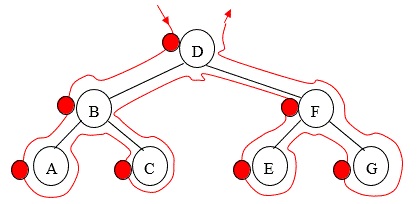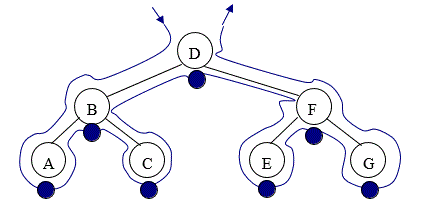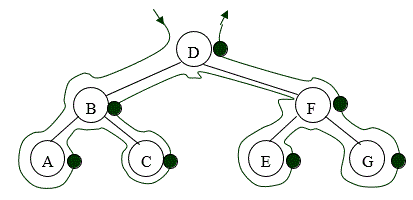Difference between revisions of "Tree Traversals"
(→Infix / Polish / Reverse Polish) |
|||
| Line 41: | Line 41: | ||
{| class="wikitable" | {| class="wikitable" | ||
|- | |- | ||
| − | ! Traversal !! Notation|- | + | ! Traversal !! Notation |
| + | |- | ||
| Pre Order || Polish | | Pre Order || Polish | ||
|- | |- | ||
Revision as of 07:54, 22 May 2017
Pre Order
Starting to the left of the root, draw an outline around the tree as shown in Figure 10. As you pass to the left of a node (where the red dot is marked) output the data in that node, i.e. DBACFEG
Algorithm
- If tree empty do nothing
Otherwise
- Visit the root (e.g. print the value of the data item at the root)
- Traverse the left sub-tree in pre-order
- Traverse the right sub-tree in pre-order
In Order
Starting to the left of the root, draw an outline around the tree as shown in Figure 11. As you pass underneath a node (where the blue dot is marked) output the data in that node, i.e. ABCDEFG
Algorithm:
- If tree empty do nothing
Otherwise:
- Traverse the left sub-tree in in-order
- Visit the root
- Traverse the right sub-tree in in-order
Post Order
Starting to the left of the root, draw an outline around the tree as shown in Figure 12. As you pass to the right of a node (where the green dot is marked) output the data in that node, i.e. ACBEGFD
Algorithm:
- If tree empty do nothing
Otherwise:
- Traverse the left sub-tree in post-order
- Traverse the right sub-tree in post-order
- Visit the root
Infix / Polish / Reverse Polish
If you create a binary tree for any given expression:
| Traversal | Notation |
|---|---|
| Pre Order | Polish |
| In Order | Infix |
| Post Order | Reverse Polish |


